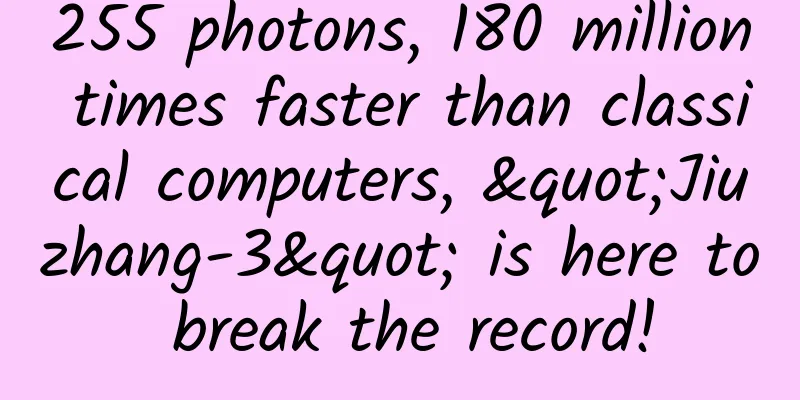255 photons, 180 million times faster than classical computers, "Jiuzhang-3" is here to break the record!

|
On the 11th, a research team composed of Pan Jianwei, Lu Chaoyang, Liu Naile and others from the Institute of Quantum Information and Quantum Technology Innovation of the Chinese Academy of Sciences at the University of Science and Technology of China, in cooperation with the Shanghai Institute of Microsystem and Information Technology of the Chinese Academy of Sciences and the National Parallel Computer Engineering Technology Research Center, successfully built a 255-photon quantum computing prototype "Jiuzhang-3", once again breaking the world record for the technical level of optical quantum information and the superiority of quantum computing. Researchers have designed a new method for photon detection with spatiotemporal demultiplexing, built a high-fidelity quasi-photon number resolvable detector, and improved the level of photon manipulation and quantum computing complexity. According to the publicly published optimal classical precision sampling algorithm, the speed of "Jiuzhang-3" in processing Gaussian boson sampling is one million times faster than that of the previous generation "Jiuzhang-2". The highest complexity sample processed by "Jiuzhang-3" in one millionth of a second would take the current most powerful supercomputer "Frontier" more than 20 billion years. This achievement further consolidates my country's international leading position in the field of optical quantum computing. Based on the construction of the Jiuzhang series of optical quantum computing prototypes, the USTC research team revealed the mathematical connection between Gaussian boson sampling and graph theory, and solved two types of graph theory problems with practical value, dense subgraphs and Max-Haf, which were 180 million times faster than the precise simulation of classical computers . In addition, it also demonstrated the advantages of unconditional multi-photon quantum precision measurement for the first time in the world. From 76 photons to 113 photons, and then to 255 photons In principle, quantum computers can obtain stronger computing power than classical computers in some problems of great social and economic value through specific algorithms. As early as 1981, Feynman proposed the initial idea of quantum computing. The physical realization of large-scale quantum computers is one of the major challenges at the forefront of world science and technology. The development of fault-tolerant general quantum computing is still far from the current level of human scientific and technological development due to its stringent fault tolerance threshold and large number of quantum bits. Therefore, the international academic community has adopted a three-step roadmap to achieve the physical realization of quantum computing. The first milestone is academically known as "quantum computing superiority", which means that by manipulating nearly 100 physical bits with high precision, it is used to efficiently solve specific high-complexity mathematical problems that even supercomputers cannot solve within a reasonable time, experimentally proving the quantum computing acceleration concept proposed by Feynman forty years ago and refuting the "Extended Church-Turing Thesis". Bose sampling based on photons and random circuit sampling based on superconducting bits are two important schemes for experimentally demonstrating the superiority of quantum computing. Pan Jianwei's team has always been at the international leading level in optical quantum information processing. In 2017, the team built the world's first optical quantum computing prototype that surpassed early classical computers. In 2019, the team further developed the world's highest performance single-photon source with deterministic polarization, high purity, high homogeneity and high efficiency, and realized Bose sampling of 20-photon input 60-mode interference circuits, and the output Hilbert state space dimension reached 1014, approaching "quantum computing superiority." In 2020, Pan Jianwei's team successfully built a Gaussian boson sampling quantum computing prototype "Jiuzhang" with 76 photons and 100 modes. The output quantum state space scale reached 1030, and the speed of processing Gaussian boson sampling was one hundred trillion times faster than that of a supercomputer. At the same time, it overcame the loophole that quantum superiority in Google's random circuit sampling experiment based on the "Platanus" superconducting processor depended on the number of samples. In 2021, a research team composed of Pan Jianwei, Lu Chaoyang, Liu Naile and others from the University of Science and Technology of China cooperated with the Shanghai Institute of Microsystem and Information Technology of the Chinese Academy of Sciences and the National Parallel Computer Engineering Technology Research Center to develop theoretical and experimental methods for stimulated amplification of quantum light sources, built a quantum computing prototype "Jiuzhang-2" with 113 photons and 144 modes , realized phase programmability, and completed the rapid solution of Gaussian boson sampling tasks used to demonstrate the "superiority of quantum computing". "Jiuzhang-2" processes Gaussian boson sampling 10 to the 24th power times faster than the fastest supercomputer at the time. What exactly is a photon? Light quanta are also called photons. This term was first proposed by Einstein in a famous paper published in 1905. Due to the great success of the photon theory, Einstein won the Nobel Prize in Physics in 1921. So, what exactly is a photon? In daily life, light is the most familiar thing to people. Without light, people simply cannot live. However, people have gone through a difficult and tortuous road to understand the nature of light. A theory represented by Newton holds that an object emits light because it emits a stream of light particles (microparticles), and the reason why we can see light is because these particles fall on our eyes and cause vision. According to this theory, people explain the reflection phenomenon of light as the result of elastic collision of light particles on the reflecting surface. However, Huygens, a contemporary of Newton, believed that the light emitted by objects is a kind of wave, which is different from the water waves and sound waves that people usually observe - they all have a medium for propagating waves. The medium for water waves is water, and the medium for sound waves is air or other liquids and solids. The propagation of light waves takes place in a vacuum, that is, light waves use vacuum as their medium. The two theories conflicted from the beginning, but due to Newton's high prestige in the scientific community, the particle theory of light dominated for a long time. Until the early 19th century, the interference, diffraction and polarization phenomena of light discovered by Young, Fresnel and Fraunhofer were very consistent with Huygens' wave theory of light, but Newton's particle theory of light could not explain them. With the development of optical instruments, optical theory has also made great progress. After Maxwell proved that light waves are electromagnetic waves, the wave theory of light seemed to be completely confirmed by experiments, and the statement that light is a wave was generally accepted by people. However, the theory that light is a wave has always been powerless in the face of the experimental results of the photoelectric effect. The so-called photoelectric effect refers to the fact that when light is irradiated on the surface of a metal, electrons will be knocked out of the metal. As early as 1872, Stoletov of Moscow University had discovered this phenomenon, and later German physicists Hertz and Renard also studied it. When people tried to explain the photoelectric effect with the wave theory of light, they concluded that when the intensity of light increases, the speed of electrons knocked out of the metal should also increase. However, the experimental results show that when irradiated with light of the same frequency, no matter how strong the light intensity is, all observed electrons have the same speed, that is, the speed of electrons knocked out of the metal has nothing to do with the intensity of light! Moreover, only when the frequency of light reaches a certain limit value will electrons fly out of the metal under light conditions. Moreover, whether electrons can be knocked out of the metal is related to the frequency of light, that is, the speed of electrons flying out when irradiated with purple light is greater than the speed of electrons flying out when irradiated with red light! Therefore, the theory that light is a wave has fallen into a dilemma in the face of experiments. Einstein used creative thinking to examine the photoelectric effect from a completely different perspective. He proposed the theory that light is a photon. According to this theory, the energy of light is composed of discontinuous minimum unit energy, and the size of this unit energy is directly proportional to the frequency of light. Light still has a frequency (or wavelength) like a wave, but it also has the characteristics of a tiny "particle" - a unit of energy. In this way, light is nothing more than a stream of energy, and the smallest unit energy is called a photon. When light shines on the surface of a metal, the light transfers the energy of the photon to the electron, and the photon disappears. The electron gets the energy of the photon, plus its own energy, and may fly out of the metal. Since the energy of a photon is only related to the frequency of light, only light with a frequency greater than a certain frequency can provide enough energy to knock electrons out of the metal. In this way, the theory of photons explains the photoelectric effect in a concise and clear way. Einstein's success earned him the Nobel Prize in Physics, but the light quantum theory has brought back to people the discussion of the nature of light that began more than 100 years ago: What exactly is light? Is it a wave or a particle? The development of physics has forced people to accept the statement that light sometimes appears as a wave (such as interference and diffraction of light) and sometimes as a particle (such as incidence and reflection of light). However, light is neither a wave like water waves or sound waves, nor a material particle like tiny particles. Light has the wave-particle duality, that is, wave-particle duality. So why do people see sunlight or other light sources that emit light that is always stable and continuous, rather than in pieces? This is because the energy of a photon is very small. It is expressed in mathematical form as the famous Planck relation E=hv, where h is called the Planck constant and its value is 6.62618×10-34 joule seconds. Although this value is so small, it has a great impact on the development of physics and people's understanding of the nature of light. Suppose we light a 25-watt light bulb and regard the emitted light as yellow light, then this beam of light contains 6×1019 photon energy units, or in other words, this beam of light emits 6×1019 photons, that is, 600 trillion energy units per second. Due to the visual persistence of the human eye, when so many photons are emitted at such a fast speed, the human eye cannot perceive the photons one by one, and what is seen is a continuous beam of light. It can be seen that a photon is the smallest unit of energy, not a material particle. Although the energy of a photon is related to the frequency, it is not the wave we usually see. In general, the quantum supremacy experiment is not a one-time job, but a competition between faster classical algorithms and ever-improving quantum computing hardware, but ultimately quantum parallelism will produce computing power that classical computers cannot achieve. Source: Science Popularization China Comprehensive Science and Technology Daily |
Recommend
Tens of thousands of conches are needed to extract 1 gram of this dye, which is the color of the rich and powerful.
Today we will talk about a dye that was once glor...
The mistake that must not be made: the truth behind the failure of 17 companies to enter the New Third Board
Don’t think that listing 3,000 companies in one y...
The deadline for the new mobile game policy is approaching, and some manufacturers may "go overseas" to make a living
The "Notice on the Management of Mobile Game...
Have you ever used the black technology code? The god-like automatic code app
When we share screenshots, we usually block out o...
How much does it cost to be an agent for a pet mini program in Chizhou?
How much does it cost to be an agent for a pet mi...
The era of paid content: both a hot topic and a hidden crisis
Last year, a wave of paid content entrepreneurshi...
Run a lucky draw in 6 steps and double your Weibo followers!
Lucky draw activities are an important tool for i...
Sales volume declined, but profits soared by 52%. How did Great Wall Motors do it?
Data shows that Great Wall Motors sold 62,186 new...
Taro: A poisonous "grain"
The entire taro plant is poisonous, and even locu...
Foreign beauty birthday blessing video private custom shooting
What I want to introduce to you today is the late...
Solar roof cut short, Musk may launch new convertible
Tesla CEO Elon Musk said earlier this year that t...
Low budget user growth model!
"Growth hacking" must be familiar to th...
B station promotion and fan-attracting skills
In summer, I believe it is not uncommon for every...
Peach gum = cheap bird's nest? Is it really that magical?
In the spring, peach blossoms bloomed quietly, pe...
Template for planning fission activities!
1. #Split the wheel lottery game and get a gift b...









